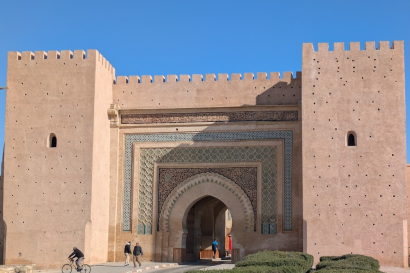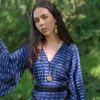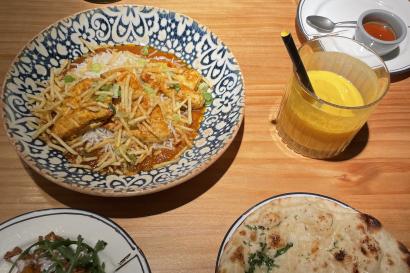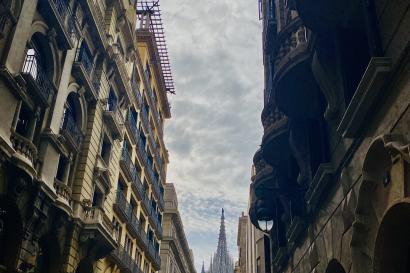
After getting a taste of the desert and Casablanca, we decided to check out Fes and Meknes the weekend after our midterms. On Friday, we arrived in Meknes in the early afternoon. We enjoyed a horse-drawn carriage ride around Meknes, which was a very cool way to see the city. Both of our carriages looked like something out of a fairytale. It was also pretty funny to ride them on the busy streets. Meknes has a lot of these horse-drawn carriages, so the cars just tolerate being behind them and going slow in roundabouts and such. Meknes is home to some pretty cool sites. We saw an ancient granary, where they used to store fish and grains for the townspeople. Because of the design and materials used in the granary, it felt air-conditioned, which was definitely welcome on a hot July day in Morocco! We also got to see the largest gate in Africa, which was, as most Moroccan gates are, beautiful! The highlight for me, however, was seeing the ancient prison, where the king used to hold political prisoners hundreds of years ago. It was underground and massive. The prison extends from Meknes to Fes (about 60 kilometers) and it is pitch black. Most of the prison is walled off now, since a few years ago two French tourists were lost in the prison and never found. Truly creepy!
Instead of staying in a hostel in Meknes, we connected with some host families who live in Meknes medina. It was really nice to meet more Moroccan people through these host families and we enjoyed practicing our Darija over couscous. That night, we went out exploring and saw a music festival in one of the parks. The next morning, we got up early and took petit taxis to the Volubilis, which are the ruins of the Roman Empire’s capital in North Africa. A lot of the elaborate mosaics were really well preserved, so it was easy to identify the ancient hammam and temples. The pillars of the largest temple, Jupiter’s Temple, were still standing as well. It started to get really hot, so I’m glad we went in the morning—even so, I still got sunburned!
After visiting the ruins, we got on our train to Fes. We stayed in the same hostel that facilitated our desert trip a few weeks prior. After a quick nap, we decided to go in search of a place called Café Clock, which some American students that we had met in Meknes recommended to us. They warned us that the food was “American styled,” but we decided American food would be an appropriate way to celebrate the 4th of July. We then bravely ventured into the Fes medina.
The Fes medina is unlike any of the other medinas I’ve seen in Morocco. It has over 9000 streets that wind and twist. Fes is touristy, so there are many aggressive “tour guides” who will try to lead you deep into the medina and then demand payment. We fell victim to two of these con artists, and found ourselves very stressed, very lost and a few dirhams poorer. Thanks to a friendly shopkeeper, we eventually ditched our “guides” and found Café Clock. There, we enjoyed camel burgers, which were surprisingly delicious, and chocolate milkshakes. Wary of entering the fray of the medina again, we took petit taxis back to the hostel.
The next morning we decided that we would go on the guided tour of Fes offered by the hostel rather than try to explore on our own. We got to see the world’s oldest university, which was built by a woman in the 9th century. We visited a Koranic school as well as blanket weaver’s workshop. The classic Moroccan blankets are made entirely out of the fibers of an agave plant. The fibers are pulled apart, spun into thread and dyed with natural colors. The looms used to weave the blankets can be so large that three men need to operate them!
Next, we visited the famous Fes tannery. Everyone warned us about how bad it would smell. The tannery workers even give you a sprig of mint to hold under your nose as you tour. However, while the smell wasn’t great, it definitely wasn’t as bad as I was expecting. The Fes tannery processes both cow and camel hide. We got to see three steps in the process of leather making: the washing of the hide, the drying of the hide, and the dying of the hide. The vats of dye were huge! The men working on that part of the process were up to their waists in dye. Afterwards, we went to a cooperative where they make the famous Moroccan argan oil. We got to watch the women who work there extract the oil from the nuts and learn about the different qualities of the oil. As a lover of argan oil, I really enjoyed learning more about it. After our tour, we went to the train station and headed back to Rabat. While I enjoyed seeing the different trades in Fes, I wish the first night in the medina had gone better. The biggest draw to Fes is the medina, but I have to say I prefer the medina in Rabat!

Chloe Zagrodzky
<p>Chloe Zagrodzky is a rising junior at Claremont McKenna College majoring in Government and Leadership. When not reading the Federalist Papers for the 100th time, she can be found practicing her French skills, running or preparing to compete with her Mock Trial team. Her list of favorite things includes dogs of all shapes and sizes, reasonably priced mochas and creative Instagram captions.</p>









